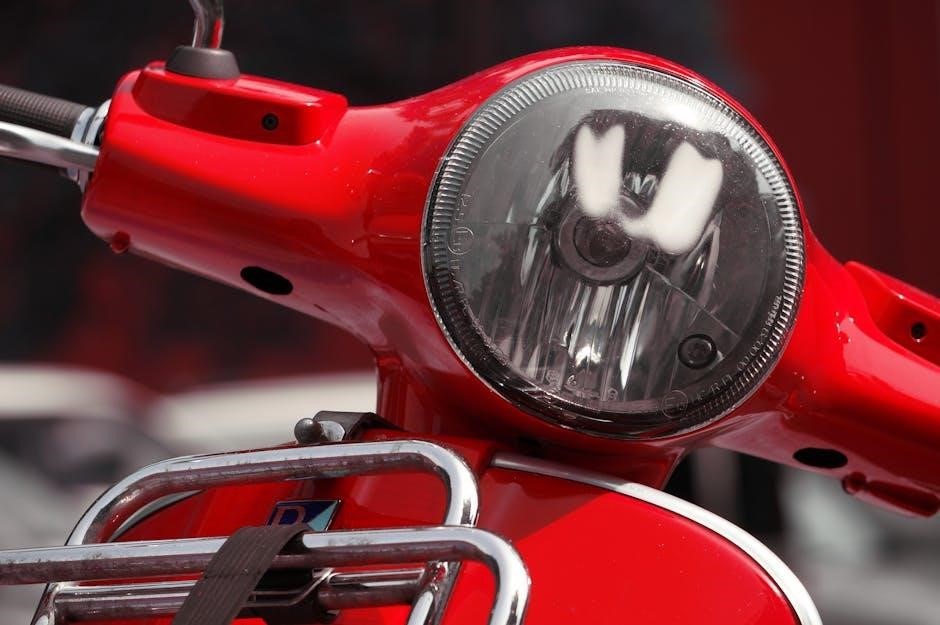pride mobility scooter repair manual pdf
Pride Mobility scooter repair manuals provide comprehensive guidance for maintaining and repairing Pride scooters. These manuals are essential for troubleshooting and ensuring optimal performance. Available in PDF format‚ they offer detailed instructions‚ diagrams‚ and safety tips. Whether you’re a amateur or professional‚ these resources help extend the lifespan and functionality of your scooter.
Overview of Pride Mobility Scooters
Pride Mobility scooters are renowned for their durability‚ comfort‚ and innovative design‚ catering to diverse mobility needs. They offer a wide range of models‚ from lightweight folding scooters to heavy-duty units‚ ensuring versatility for users. These scooters are designed to enhance independence and ease of use‚ with features like adjustable seating‚ robust batteries‚ and intuitive controls. Regular maintenance and repairs‚ guided by the repair manual‚ are crucial for preserving performance and longevity‚ ensuring users continue to benefit from reliable mobility solutions.
Importance of a Repair Manual
A repair manual is essential for maintaining and repairing Pride Mobility scooters‚ providing step-by-step guidance for troubleshooting and fixing issues. It ensures safety by outlining proper repair procedures and safety precautions. The manual empowers users to address common problems independently‚ saving time and money. It also includes diagrams and technical specifications‚ helping users understand complex systems. Regular use of the manual extends the scooter’s lifespan and ensures optimal performance‚ making it a vital resource for both novice and experienced users.
Key Features of the Pride Mobility Scooter Repair Manual PDF
The Pride Mobility Scooter Repair Manual PDF is designed to be user-friendly‚ with clear organization and a detailed table of contents for easy navigation. It includes high-quality diagrams and schematics to visually guide repairs‚ as well as comprehensive troubleshooting sections for common issues. Safety is emphasized with dedicated guidelines and precautions. The manual is regularly updated to reflect the latest scooter models and technologies. Accessible on multiple devices‚ it features a parts directory for easy identification and sourcing of components. Instructions cater to both basic and advanced repairs‚ with additional maintenance tips to prevent future problems. Customer support information is also provided for further assistance‚ ensuring a well-rounded resource for scooter upkeep and repair.
Safety Precautions and Guidelines
Always wear protective gear‚ ensure the scooter is stable‚ and disconnect power before repairs. Use proper tools and follow guidelines to avoid injury or damage.
General Safety Tips for Scooter Repair
Always disconnect the battery before starting repairs to prevent accidental start-ups. Use jack stands for stability and ensure proper ventilation. Avoid wearing loose clothing and keep long hair tied back. Never bypass safety features or skip precautions outlined in the manual. Conduct repairs on a flat‚ stable surface and test the scooter cautiously after completing work. Wear protective gear like gloves and safety glasses to minimize risks during the process.
Protective Gear and Tools Required
Essential protective gear includes safety glasses‚ gloves‚ and a face mask to prevent injury from debris or electrical components. A multimeter‚ screwdrivers‚ and wrenches are vital for diagnosing and repairing electrical and mechanical issues. Ensure you have a torque wrench for precise bolt tightening and pliers for gripping small parts. Additional tools like a work light and a battery tester can enhance visibility and efficiency during the repair process. Always use high-quality tools to ensure reliability and safety.
Understanding Safety Warnings in the Manual
The Pride Mobility scooter repair manual PDF includes critical safety warnings to prevent accidents and ensure proper repairs. These warnings highlight risks such as electrical shocks‚ mechanical failures‚ and personal injury. Always read and adhere to these guidelines to avoid hazards. Specific cautions are provided for tasks like battery handling‚ wiring repairs‚ and disassembling components. Ignoring these warnings can lead to severe consequences. Consult a professional if unsure‚ and stay updated with any manual revisions for enhanced safety. Proper adherence ensures a safe and successful repair process. Always prioritize caution when working with electrical systems and moving parts.

Pre-Repair Checks and Diagnostics
Pre-repair checks ensure the scooter is thoroughly inspected and diagnosed for issues‚ preparing it for safe and effective repairs. Always review the manual first.
Initial Inspection of the Scooter
The initial inspection is crucial for identifying visible damage or wear. Check the frame‚ tires‚ brakes‚ and electrical components for any obvious issues. Test the controls and ensure all functions operate smoothly. Inspect the battery terminals for corrosion and verify tire pressure. Review the manual for specific inspection guidelines tailored to your scooter model. Document any findings to guide the repair process effectively.
Using Diagnostic Tools and Techniques
Diagnosing issues with your Pride scooter requires the right tools and techniques. Use a multimeter to test electrical circuits and batteries. Fault code readers can help identify specific errors in the scooter’s computer system. Refer to the manual for guidance on using these tools effectively. Perform tests in a safe‚ well-lit area‚ and always follow the manufacturer’s instructions. This ensures accurate diagnoses and prevents further damage to the scooter’s components.
Identifying Common Issues
Common issues with Pride scooters include battery drainage‚ faulty brakes‚ and electrical malfunctions. Check for loose connections‚ worn tires‚ or damaged wiring. Consult the manual for troubleshooting guides specific to your model. Look for error codes or unusual noises that indicate problems. Regularly inspect components like the motor‚ controller‚ and suspension for wear. Addressing these issues early prevents major repairs and ensures optimal performance. Always refer to the manual for precise diagnostic steps and solutions.

Troubleshooting Common Problems
Troubleshooting involves diagnosing issues like battery drainage‚ faulty brakes‚ or electrical faults. Check connections‚ error codes‚ and test components. Use diagnostic tools and manual guidance.
Electrical System Issues
Common electrical problems include short circuits‚ blown fuses‚ or faulty connections. Use a multimeter to test wires and connections. Check for error codes in the control panel. Ensure the battery is charged and terminals are clean. Consult the manual for wiring diagrams to trace issues. Avoid exposure to water‚ as it can damage electrical components. If problems persist‚ consult a professional technician. Regular inspections can prevent electrical failures and ensure smooth operation of the scooter.
Mechanical Component Failures
Mechanical issues often involve the braking system‚ tires‚ or axle. Symptoms include unusual noises‚ vibrations‚ or loss of mobility. Inspect for worn or loose parts‚ such as brake pads or bearings. Lubricate moving components regularly to prevent friction damage. Replace damaged tires or wheels promptly. Consult the manual for torque specifications when tightening bolts. Addressing mechanical failures early prevents further damage and ensures safe‚ reliable scooter operation. Always follow the repair manual’s guidelines for disassembly and reassembly.
Battery and Charging Problems
Battery issues often cause power loss or slow charging. Check for loose connections or corrosion on terminals. Verify the charger is functioning correctly and indicators light up. Deep discharging can reduce battery life; avoid draining below 20%. If the scooter doesn’t power on‚ test the battery voltage with a multimeter. Replace the battery if it fails to hold charge. Consult the manual for charging procedures and troubleshooting steps to resolve electrical supply problems effectively.

Step-by-Step Repair Guides
Utilize the manual’s detailed instructions for systematic repairs. Diagnose issues with diagnostic tools‚ follow sequential steps for brake‚ motor‚ and electrical fixes‚ ensuring accuracy and safety.
Repairing the Braking System
Begin by inspecting the brake components‚ including pads‚ levers‚ and cables‚ for wear or damage. Consult the manual for specific instructions tailored to your scooter model. Identify common issues like weak braking performance or spongy levers‚ which may indicate fluid leaks or cable misalignment. Follow step-by-step guides to replace worn pads or adjust cable tension. Ensure proper alignment and lubrication of moving parts. Test the brakes thoroughly after repairs to confirm functionality and safety. Always use genuine replacement parts for optimal performance.
Replacing the Tires and Wheels
Start by removing the battery to ensure safety. Use a jack to lift the scooter and support it with jack stands. Remove the wheels by taking out the axle bolts or clips‚ depending on your model. Inspect the hubs and bearings for wear. Install new tires‚ ensuring proper fitment and alignment. Tighten all bolts securely‚ following torque specifications in the manual. Refer to manufacturer guidelines for tire compatibility and inflation levels. Test the scooter after replacement to ensure stability and proper function.
Fixing the Steering and Suspension
To fix the steering and suspension‚ start by inspecting for loose or worn-out components. Tighten any loose connections or bolts using the tools specified in the manual. If parts like bearings or bushings are damaged‚ replace them with genuine Pride Mobility parts. Ensure proper alignment of the steering column and adjust as needed for smooth operation. Refer to the torque specifications in the manual for secure fastening. After repairs‚ test the scooter to ensure stable handling and proper suspension response.

Maintenance and Upkeep
Regular maintenance ensures optimal performance and longevity. Follow the manual’s schedule for cleaning‚ lubricating‚ and inspecting components. Address wear and tear promptly to prevent major issues.
Regular Maintenance Schedule
A well-planned maintenance schedule is crucial for extending the scooter’s lifespan. The Pride Mobility manual outlines tasks like cleaning the scooter‚ lubricating moving parts‚ and checking battery connections monthly. Every 3 months‚ inspect tires for wear and brakes for proper function. Annually‚ check electrical systems and tighten all bolts and screws. Following this schedule ensures reliability‚ safety‚ and optimal performance. Regular checks prevent minor issues from becoming major repairs‚ keeping your scooter in top condition.
Cleaning and Lubricating Moving Parts
Regular cleaning and lubrication are essential for maintaining smooth operation. Use a soft cloth and mild detergent to wipe down frames‚ joints‚ and mechanisms. Avoid harsh chemicals that may damage finishes. Lubricate moving parts like axles‚ hinges‚ and brakes with silicone-based sprays every 1-2 months. This prevents rust and wear‚ ensuring optimal performance. Always wipe off excess lubricant to avoid attracting dust. Follow the manual’s guidelines for specific areas needing attention to keep your scooter running smoothly and quietly.
Upgrading or Replacing Accessories
Upgrading or replacing accessories on your Pride Mobility Scooter can enhance functionality and comfort. Ensure all parts are compatible with your model‚ as specified in the manual. Follow installation steps carefully to maintain safety and performance. Use genuine or approved aftermarket accessories to avoid voiding the warranty. Always disconnect the battery before making changes. Test the scooter after installation to ensure proper operation. Keep receipts and documentation for future reference or warranty claims.

Using the Repair Manual Effectively
Effectively using the Pride Mobility Scooter Repair Manual involves understanding its structure‚ utilizing the index for quick navigation‚ and following detailed step-by-step instructions. Referencing technical diagrams ensures accurate repairs‚ while adhering to safety protocols guarantees a secure process. Familiarize yourself with the manual’s layout to maximize efficiency and minimize errors during maintenance or repairs.
Navigating the PDF Manual
Navigating the Pride Mobility Scooter Repair Manual PDF is straightforward with its organized layout. Use the table of contents to quickly locate sections‚ and employ bookmarks for easy access to frequently referenced pages. The search function allows users to find specific topics instantly. Familiarize yourself with the index to locate diagrams‚ error codes‚ or repair procedures efficiently. Utilize keyboard shortcuts to navigate seamlessly through the document‚ ensuring a hassle-free experience when diagnosing or repairing your scooter.
Understanding Technical Diagrams and Schematics
Understanding technical diagrams and schematics in the Pride Mobility Scooter Repair Manual PDF is crucial for effective repairs. Diagrams provide visual representations of components‚ while schematics detail electrical circuits and connections. Look for labels‚ symbols‚ and color codes to identify parts and their functions. Use the legend or key provided in the manual to interpret complex diagrams. Cross-reference schematics with the scooter’s actual wiring to ensure accurate diagnostics and repairs‚ enhancing your ability to troubleshoot and fix issues efficiently.
Interpreting Repair Codes and Error Messages
Interpreting repair codes and error messages in the Pride Mobility Scooter Repair Manual PDF is essential for diagnosing issues accurately. The manual lists common error codes‚ such as E1‚ E2‚ or E3‚ each corresponding to specific problems like battery faults or sensor malfunctions. Refer to the code list in the manual for precise definitions. Understanding these codes helps identify root causes‚ guiding you to the correct repair procedures. Always address error messages promptly to prevent further damage or safety hazards‚ ensuring your scooter operates reliably and safely.

Advanced Repair Techniques
Advanced repair techniques involve intricate mechanical adjustments and complex electrical diagnostics; The manual provides detailed guidance for specialized repairs‚ ensuring precision and efficiency in resolving sophisticated issues.
Wiring and Electrical Repairs
Wiring and electrical repairs require careful diagnostics to identify faults in the scooter’s circuitry. The manual provides step-by-step instructions for tracing wiring issues‚ repairing damaged cables‚ and replacing faulty electrical components. Common problems include short circuits‚ blown fuses‚ or malfunctioning sensors. Proper tools‚ such as multimeters‚ are essential for accurate diagnostics. Always disconnect the battery before starting electrical work to ensure safety. Detailed diagrams in the manual help visualize complex wiring systems‚ making repairs more manageable for both novice and experienced users.
Motor and Controller Maintenance
Motor and controller maintenance is crucial for ensuring smooth operation and longevity. The repair manual provides detailed procedures for inspecting and cleaning the motor‚ checking connections‚ and verifying proper alignment. It also covers troubleshooting motor performance issues‚ such as uneven power delivery or overheating. Regular maintenance tasks‚ like lubricating moving parts and updating firmware‚ are emphasized. Proper care extends the lifespan of these critical components‚ ensuring reliable scooter functionality and performance over time.
Advanced Diagnostic Procedures
Advanced diagnostic procedures in the Pride Mobility Scooter Repair Manual PDF offer in-depth troubleshooting methods for complex issues. These include detailed system checks‚ error code analysis‚ and specialized tests for electrical and mechanical components. The manual guides users through advanced techniques to identify and resolve hidden faults‚ ensuring precise repairs. By following these procedures‚ technicians can efficiently pinpoint root causes and restore scooter functionality to optimal levels‚ minimizing downtime and enhancing user satisfaction.

Post-Repair Testing and Quality Assurance
Post-repair testing ensures the scooter operates safely and efficiently. Conduct a thorough inspection‚ test all systems‚ and verify performance meets manufacturer standards for optimal functionality and user satisfaction.
Testing the Scooter After Repairs
After completing repairs‚ test the scooter thoroughly to ensure all systems function correctly. Check the brakes‚ throttle response‚ and lights. Test on a flat surface and inclines to verify stability. Inspect tire pressure and traction. Ensure the battery holds a full charge and discharges properly. Refer to the repair manual for specific testing procedures and safety guidelines. Conduct a final inspection to confirm all repairs are secure and the scooter is safe to use.
Ensuring Safety and Performance
After repairs‚ ensure the scooter meets safety and performance standards. Verify all safety features‚ such as brakes and lights‚ function properly. Test acceleration‚ speed‚ and maneuverability on various terrains. Check for any unusual noises or vibrations. Ensure the battery operates efficiently and the scooter maintains balance. Refer to the manual for performance benchmarks. Confirm all repairs align with manufacturer guidelines to guarantee reliability and safety for the user.
Documenting the Repair Process
Documenting the repair process is crucial for tracking progress and future reference. Keep a detailed log of repairs‚ including dates‚ parts replaced‚ and steps taken. Use before-and-after photos to visually record changes. Note serial numbers of replaced components and reference manual pages used. Store records securely‚ as they may be needed for warranty claims or future diagnostics. This organized approach ensures transparency and accountability‚ benefiting both the technician and the scooter’s owner.

Warranty and Service Options
Pride Mobility offers comprehensive warranty coverage for scooters‚ covering parts and labor for specified periods. Authorized service centers provide expert repairs‚ ensuring compliance with warranty terms. Extended warranty options are available for added protection and peace of mind. Regular maintenance by certified technicians helps maintain warranty validity and ensures optimal scooter performance over time.
Understanding the Manufacturer’s Warranty
The Pride Mobility scooter repair manual PDF includes details about the manufacturer’s warranty‚ which covers parts and labor for a specified period. Warranty coverage varies by model but typically includes 2-3 years for the scooter and up to 5 years for the frame. Registration is often required to activate warranty benefits. The warranty protects against defects in materials and workmanship‚ ensuring users can address issues without additional costs. Transferable warranties may also be available‚ enhancing the scooter’s resale value.
Authorized Service Centers and Support
For reliable assistance‚ Pride Mobility recommends using authorized service centers. These centers employ trained technicians with access to genuine parts and updated repair protocols. Users can locate authorized centers through Pride Mobility’s official website or contact customer support for referrals. These centers ensure repairs align with warranty terms and maintain scooter performance. Additionally‚ they offer personalized support‚ ensuring issues are resolved efficiently and safely‚ providing peace of mind for scooter owners seeking professional assistance.
Extended Warranty and Insurance Options
Extended warranty and insurance options provide financial protection for Pride Mobility scooter owners. These plans often cover repairs beyond the standard warranty period and may include accidental damage or theft. Users can purchase extended warranties through Pride Mobility or authorized dealers. Insurance options vary but typically offer liability coverage and protection against unforeseen events. Reviewing the terms and conditions ensures the chosen plan meets specific needs‚ providing peace of mind and safeguarding against unexpected costs.

Additional Resources and Support
Pride Mobility offers online forums‚ video tutorials‚ and customer service for repair guidance. These resources provide additional help beyond the manual‚ ensuring successful repairs and troubleshooting.
Online Forums and Communities
Online forums and communities dedicated to Pride Mobility scooter repairs are invaluable resources. Websites like Pride’s official forum or mobility-focused groups offer troubleshooting tips‚ DIY guides‚ and expert advice. Users can share experiences‚ ask questions‚ and receive real-time feedback from seasoned technicians and enthusiasts. These platforms often include downloadable resources‚ repair tutorials‚ and discussions on common issues‚ helping users resolve problems efficiently. Engaging with these communities fosters a supportive environment and ensures access to the latest information and solutions.
Video Tutorials and Repair Guides
Video tutorials and repair guides provide visual‚ step-by-step instructions for repairing Pride Mobility scooters. Available on platforms like YouTube and official Pride websites‚ these resources complement the repair manual PDF by offering hands-on demonstrations. They cover common fixes‚ such as battery replacements and brake adjustments‚ and often include troubleshooting tips. These guides are especially useful for visual learners‚ helping users understand complex procedures more easily. They also serve as a practical companion to the written manual‚ enhancing the repair experience with clear‚ actionable content.
Customer Service and Technical Support
Pride Mobility offers comprehensive customer service and technical support to assist with scooter repairs. Their dedicated team provides guidance via phone‚ email‚ or live chat‚ addressing queries and troubleshooting issues. Additionally‚ online resources‚ such as FAQs and support articles‚ are available for quick solutions. Pride’s support team ensures users can effectively use the repair manual PDF‚ offering expert advice and clarifying complex procedures. This support system enhances the repair experience‚ ensuring users can maintain their scooters with confidence and ease.
The Pride Mobility Scooter Repair Manual PDF empowers users to maintain and repair their scooters confidently‚ ensuring optimal performance and longevity with clear‚ detailed guidance.
Final Tips for Successful Repairs
Always follow the manual’s instructions precisely to avoid further damage. Double-check connections and ensure all parts are securely fastened. Test the scooter thoroughly after repairs to confirm proper function. Keep a record of maintenance and repairs for future reference. Regularly review the manual for updates or new techniques. By adhering to these guidelines‚ you’ll ensure your Pride scooter remains safe‚ reliable‚ and performs at its best for years to come.
Importance of Following the Manual
Adhering to the Pride Mobility Scooter Repair Manual ensures safety‚ accuracy‚ and compliance with manufacturer standards. Deviating from instructions can lead to improper repairs‚ safety hazards‚ or voiding the warranty. The manual provides precise guidance tailored to your scooter’s model‚ minimizing errors and downtime. Following it helps maintain your scooter’s performance‚ reliability‚ and longevity. Always prioritize the manual’s instructions to achieve professional-level results and ensure your scooter operates safely and efficiently.
Staying Informed About Updates and Improvements
Regularly checking for updates to the Pride Mobility Scooter Repair Manual PDF ensures access to the latest repair techniques‚ troubleshooting guides‚ and compatibility with newer models; Visit the manufacturer’s website or official forums for updates. New versions may include improved diagrams‚ revised procedures‚ or additional tips; Staying informed helps you perform repairs more effectively and safely. Subscribe to newsletters or follow official channels to stay updated without missing critical improvements.
